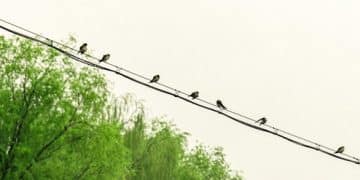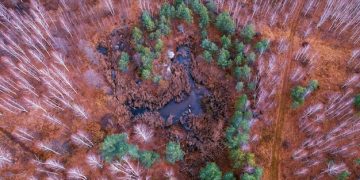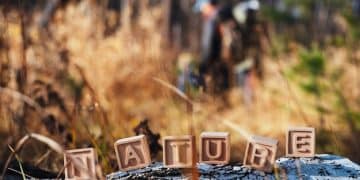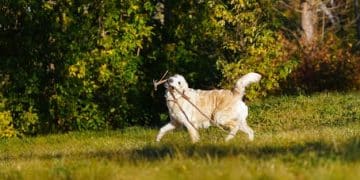Identifying Invasive Plant Species: A Homeowner’s Guide to Protecting US Wildlife

Identifying invasive plant species is crucial for US homeowners to protect local wildlife, involving recognition, removal, and prevention to ensure a healthy ecosystem.
Do you know which plants in your backyard could be harmful to local wildlife? Identifying invasive plant species threatening US wildlife: a practical guide for homeowners is essential to protecting our ecosystems.
Why Identifying Invasive Species Matters
Invasive species pose a significant threat to biodiversity and ecosystem health in the United States. These non-native plants can outcompete native flora, disrupt food chains, and alter habitats, leading to declines in local wildlife populations. Understanding the impact of invasive species is the first step in becoming a responsible homeowner.
By taking proactive measures to identify and manage invasive plants, homeowners can play a vital role in preserving the natural balance of their local environments. This not only benefits wildlife but also contributes to the overall health and resilience of ecosystems.
The Ecological Impact of Invasive Plants
Invasive plants can wreak havoc on ecosystems. They often lack natural predators or diseases that keep native plant populations in check. This allows them to spread rapidly, dominating landscapes and displacing native species.
The consequences of this displacement are far-reaching. Native plants provide food and shelter for a variety of animals, including insects, birds, and mammals. When invasive plants take over, these animals can lose their food sources and habitats, leading to population declines.
Economic Costs Associated with Invasive Species
Beyond the ecological impact, invasive species also carry significant economic costs. The United States spends billions of dollars each year on controlling and mitigating the effects of invasive plants. These costs include:
- Eradication efforts in natural areas
- Agricultural losses due to crop damage
- Increased maintenance costs for homeowners and landowners
By preventing the spread of invasive species, homeowners can help reduce these economic burdens and protect valuable resources.
Conclusively, understanding the significance of identifying and managing invasive species is paramount for safeguarding both local wildlife and the economic well-being of communities across the United States.
Common Invasive Plants in the US: A Visual Guide
Recognizing common invasive plants is crucial for effective management. Many of these species have unique characteristics that set them apart from native plants. A visual guide, coupled with detailed descriptions, can help homeowners accurately identify these invaders.
This section provides an overview of some of the most widespread invasive plants in the US, along with tips on how to identify them in your own backyard.

Japanese Honeysuckle (Lonicera japonica)
- Description: A climbing vine with fragrant white to yellow flowers.
- Impact: Smothers native vegetation and reduces biodiversity.
- Identification Tips: Look for opposite leaves and paired berries.
Kudzu (Pueraria montana)
- Description: A rapidly growing vine that blankets everything in its path.
- Impact: Blocks sunlight and kills native plants.
- Identification Tips: Check for large, three-lobed leaves and purple flowers.
Purple Loosestrife (Lythrum salicaria)
- Description: A tall perennial with spikes of purple flowers.
- Impact: Crowds out native wetland plants.
- Identification Tips: Identify the slender, four-sided stems and lance-shaped leaves.
Ultimately, gaining familiarity with these widespread invasive plants empowers homeowners to take decisive action, fostering the preservation of native ecosystems and the safeguarding of local wildlife.
Creating a Plant Inventory: Mapping Your Backyard
Before tackling invasive plant removal, it’s essential to create a comprehensive plant inventory. Mapping your backyard allows you to identify areas where invasive species are concentrated and prioritize your management efforts.
This section provides a step-by-step guide on how to create a plant inventory, ensuring that you have a clear understanding of the plant life in your yard.
Step 1: Divide Your Yard into Sections
To make the inventory process more manageable, divide your yard into smaller sections. These sections could be based on landscape features such as gardens, lawns, wooded areas, and water features.
Step 2: Identify and Record Plant Species
Walk through each section of your yard and identify the plant species present. Use a field guide or online resources to help you identify unfamiliar plants. Record the name of each plant, its location within the section, and its abundance (e.g., rare, common, abundant).
Step 3: Mark Invasive Plants on Your Map
Once you have identified the plant species in your yard, mark the locations of invasive plants on your map. Use a different color or symbol to distinguish invasive species from native plants.
By following these steps, you can create a detailed plant inventory that will guide your invasive species management efforts. This inventory will also serve as a valuable tool for monitoring the effectiveness of your removal strategies over time.
Safe and Effective Removal Techniques
Removing invasive plants requires careful planning and the use of appropriate techniques. Some removal methods can inadvertently spread invasive species or harm native plants if not implemented correctly.
This section outlines safe and effective removal techniques that homeowners can use to manage invasive plants in their yards.
Manual Removal
Manual removal involves physically removing invasive plants by hand. This method is best suited for small infestations and can be particularly effective for plants with shallow root systems.
Chemical Control
Chemical control involves the use of herbicides to kill invasive plants. This method can be effective for larger infestations, but it’s important to use herbicides selectively to minimize the impact on non-target plants and the environment.
Prevention Strategies
Preventing the introduction and spread of invasive species is the most effective long-term strategy for protecting your local wildlife. Here are some strategies you can implement:
- Inspect new plants for signs of invasive species before planting them in your yard.
- Clean your gardening tools and equipment to prevent the spread of seeds and plant fragments.
- Avoid disturbing soil unnecessarily, as this can create opportunities for invasive plants to establish.
Adopting these preventative measures can significantly reduce the risk of invasive species taking hold in your yard, thereby contributing to the overall health of your local ecosystem.
Promoting Native Plant Growth
Replacing invasive plants with native species is a key step in restoring biodiversity and supporting local wildlife. Native plants are adapted to the local climate and soil conditions, making them more resilient and better suited to provide food and shelter for native animals.
This section provides guidance on how to select and cultivate native plants that will thrive in your yard and benefit the environment.
Choosing the Right Native Plants
When selecting native plants, consider the specific conditions in your yard, such as sunlight, soil type, and moisture levels. Choose plants that are well-suited to these conditions to ensure their long-term survival.
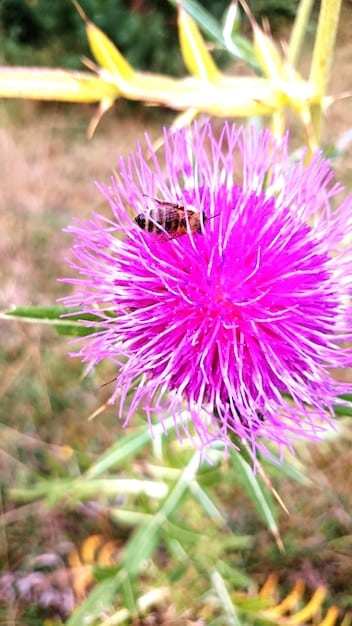
Creating a Native Plant Garden
A native plant garden can be a beautiful and ecologically beneficial addition to your yard. Here are some tips for creating a thriving native plant garden:
- Prepare the soil by removing invasive plants and amending with compost or other organic matter.
- Plant native plants in groups or drifts to create a more natural and visually appealing landscape.
- Provide water and fertilizer as needed, but avoid over-watering or over-fertilizing, as this can promote weed growth.
Benefits of Native Plants
Native plants offer several benefits to homeowners and the environment:
- They require less maintenance than non-native plants, as they are adapted to the local climate and soil conditions.
- They provide food and shelter for native animals, supporting biodiversity and ecosystem health.
- They help to conserve water, as they are typically more drought-tolerant than non-native plants.
Ultimately, incorporating native plants in your garden not only enhances its aesthetic appeal but also makes a significant contribution to environmental conservation and the well-being of local wildlife.
Staying Informed and Involved
Staying informed about invasive species and getting involved in local conservation efforts is crucial for long-term success. Invasive species management is an ongoing process, and new threats can emerge at any time.
This section provides resources and tips for staying informed and involved in the fight against invasive species.
Join a Local Conservation Group
Joining a local conservation group is a great way to learn more about invasive species and get involved in hands-on management activities. These groups often organize workdays to remove invasive plants from natural areas and educate community members about conservation issues.
Follow Expert Advice
There are many online resources and publications that provide information about invasive species and native plant gardening. Follow these resources to stay up-to-date on the latest developments and best practices.
Share Your Knowledge
Share your knowledge and experiences with others to help raise awareness about invasive species and promote responsible gardening practices. Talk to your neighbors, friends, and family members about the importance of protecting native plants and wildlife.
By actively engaging with your community, you can foster a collective commitment to preserving local ecosystems and ensuring a sustainable future for both wildlife and future generations.
| Key Aspect | Brief Description |
|---|---|
| 🌱 Identifying Threats | Learn to recognize common invasive plants in your area. |
| 🛠️ Removal Techniques | Use safe and effective methods to remove invasive species. |
| 🌿 Native Plants | Promote the growth of native plants to restore biodiversity. |
| 🌎 Community Action | Join local groups and share knowledge to combat invasive species. |
FAQ – Identifying Invasive Plant Species
▼
Invasive plant species are non-native plants that aggressively spread and cause harm to the environment, economy, or human health by outcompeting native vegetation.
▼
Homeowners should care because invasive plants can damage property, reduce biodiversity, and harm local wildlife, affecting the overall ecosystem and property value.
▼
Use field guides, online resources, or consult with local experts to identify unfamiliar plants. Look for characteristics like rapid growth, unusual leaf patterns, or lack of natural predators.
▼
Effective methods include manual removal (pulling or digging up plants), chemical control (using herbicides), and introducing natural predators or diseases (biological control), depending on the species and infestation size.
▼
Preventative measures include inspecting new plants, cleaning gardening tools, avoiding soil disturbance, and planting native species that are not prone to aggressive spreading.
Conclusion
By taking proactive steps to identify and manage invasive plants, homeowners can play a crucial role in protecting US wildlife and preserving the health of local ecosystems. Remember, a well-informed and action-oriented approach is key to a sustainable future for our natural landscapes.
